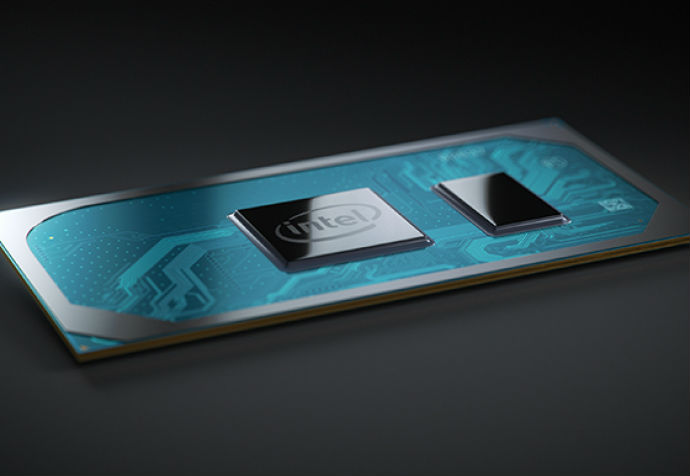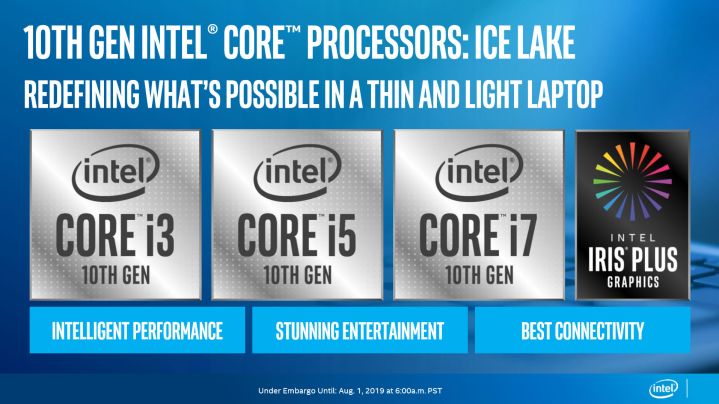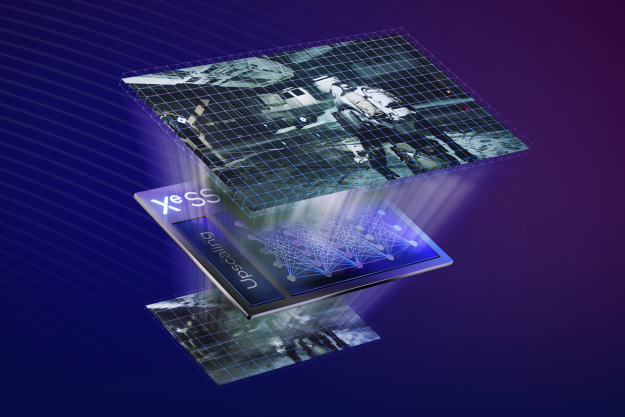
After nearly eight months of hype, we finally have the details on Intel’s 10th-gen processors, also known as Ice Lake. Intel’s struggle with the die shrink down to 10nm has finally come to an end.
Though we’ll be waiting much longer for their desktop counterparts, these mobile CPUs mark an important next step for laptops and 2-in-1s. Right now, the launch is limited to U-series and Y-series chips. Intel has promised the 10th-gen chips will appear in 35 designs before the holiday season, and we expect these to begin rolling out soon with the upcoming Dell XPS 13 2-in-1.
U-series steadies its core count

We’ve known the basics about Intel’s 10th-gen chips for a while now. Intel told us earlier this year that they’d debut new Gen11 Iris Plus integrated graphics and support next-gen connectivity standards like Wi-Fi 6. Now, we know the details on the specific processors Intel will be launching, including which will have the new Iris Plus graphics.
We can expect these U-series chips to appear in mainstream laptops and 2-in-1s, including the new Dell XPS 13 2-in-1. Here’s a look at the specs of the U-series chips:
| Core i7-1068G7 | Core i7-1065G7 | Core i5-1063G7 | Core i5-1035G4 | Core i5-1035G1 | Core i3-1005G1 | |
| Cores | 4 | 4 | 4 | 4 | 4 | 2 |
| Threads | 8 | 8 | 8 | 8 | 8 | 4 |
| Base frequency | 2.3GHz | 1.3GHz | 1.2GHz | 1.1GHz | 1.0GHz | 1.2GHz |
| Max single core turbo | 4.1GHz | 3.9GHz | 3.7GHz | 3.7GHz | 3.6GHz | 3.4GHz |
| Max all core frequency | 3.6GHz | 3.5GHz | 3.3GHz | 3.3GHz | 3.3GHz | 3.4GHz |
| Memory cache | 8MB | 8MB | 6MB | 6MB | 6MB | 4MB |
| Graphics | Iris Plus (64 EUs) | Iris Plus (64 EUs) | Iris Plus (64 EUs) | Iris Plus (48 EUs) | Intel UHD (32 EUs) | Intel UHD (32 EUs) |
| TDP | 28w | 15w / 25w | 15w / 25w | 15w / 25w | 15w / 25w | 15w / 25w |
| Series | U | U | U | U | U | U |
The first thing to notice about these new chips is the designation. “10” still marks the generation, but the “U” or “Y” letters have been replaced by a “G” to indicate graphics capabilities. That’s going to make distinguishing between the different series more difficult, as you can no longer see from a quick glance which series they belong to. Even more confusingly, the “G” label now conflicts with the previous G-series processors that used AMD Radeon discrete graphics. Clearly, with these 10th-gen chips, Intel wants its graphics to be in the limelight this time around.
Speaking of graphics, Intel has begun to use EUs (execution units) to indicate the power of its new Iris Plus integrated graphics. In the case of these U-series chips, the “Iris Plus” brand represents either 64 or 48 EUs, which is a big increase over the 32 EUs of the typical UHD graphics. Assuming we can expect more than twice the performance, basic 13-inch laptops may finally be able to compete with entry-level discrete graphics like the MX250. That means decent framerates in 1080p at most games at medium settings. We don’t yet know how much these new graphics options will add to the cost of a new laptop.

These new U-series chips don’t represent a change in core count from 8th-gen chips. They’re still four core, eight thread designs on Core i5 and Core i7, while Core i3 is limited to two cores.
Ice Lake does provide some significant increases in clock speed, though. The Core i7-1068G7, for example, gains a 22% increase in base clock over the Core i7-8565U, while losing around 10% of single-core Turbo speed. That more powerful Core i7 is the most interesting of the lot, not only for its high base clock but also its higher TDP of 28 watts. According to Intel, the slightly higher TDP is to support both the more powerful Iris Plus graphics and to enable the higher base clock.
A few of the new processors are a step down in clock speed, however. The two Core i5 parts, which are nearly identical aside from graphics, have lower clock speeds than equivalent 8th-gen predecessors. The Core i5-8265U had a faster base clock speed and a single-core Turbo boost.
Intel claims this is a result of the 10nm process being brand new, and as it matures over generations, we should expect these frequencies to increase throughout the 10nm lifecycle.
Y-series finally get four cores
Y-series chips appear in fanless laptops because of their lower thermal profile. Though less common than the U-Series, they’ve appeared in ultra-thin
| Core i7-1060G7 | Core i5-1030G7 | Core i5-1030G4 | Core i3-1000G4 | Core i3-1000G1 | |
| Cores | 4 | 4 | 4 | 2 | 2 |
| Threads | 8 | 8 | 8 | 4 | 4 |
| Base frequency | 1.0GHz | 0.8GHz | 0.7GHz | 1.1GHz | 1.1GHz |
| Max single core turbo | 3.8GHz | 3.5GHz | 3.5GHz | 3.2GHz | 3.2GHz |
| Max all core frequency | 3.4MHz | 3.2GHz | 3.2GHz | 3.2GHz | 3.2GHz |
| Memory cache | 8MB | 6MB | 6MB | 4MB | 4MB |
| Graphics | Iris Plus (64 EUs) | Iris Plus (64 EUs) | Iris Plus (48 EUs) | Iris Plus (48 EUs) | Intel UHD (32 EUs) |
| TDP | 9w / 12w | 9w / 12w | 9w / 12w | 9w / 12w | 9w / 12w |
| Series | Y | Y | Y | Y | Y |
The increased core count of the Core i7 and Core i5 Y-series does have consequences. The low 700MHz base clock of the Core i5-1030G4, for example, isn’t pretty. The same logic mentioned earlier about process maturation applies here, but it’s been awhile since we’ve seen base frequencies that low listed on a spec sheet.
These new Y-series chips have an increased TDP as well, up from 5 watts to 9 watts. Along with the extra power, these chips get an increase in cache, now including up to 8MB from a previous maximum of 4MB.
Interestingly, Intel has brought the same Iris Plus graphics to the Y-series processors. They’re available in all the processors at varying EU counts, except for the entry-level Core i3-1000G1.
AI, connectivity, and more
Of course, there’s more going on with these 10th-gen chips than just core counts and clock speeds. Intel made quite a big deal of what it calls “Deep Learning Boost,” a new set of AI-powered instructions present on all new 10th-gen chips. Previously available only on high-end Xeon-class processors, this instruction set “accelerates neural networks on the CPU for maximum responsiveness in scenarios such as automatic image enhancements, photo indexing and photorealistic effects,” according to Intel.
Connectivity was also a big emphasis. While most of the world is talking about 5G, Intel is focused on Wi-Fi 6. Its implementation is called Wi-Fi 6 Gig+, and it comes ready with all 10th-gen chips. Intel says its version is the fastest, claiming three times faster speeds than the previous generation, as well as a 75% reduction in latency.
These new chips are “launched” today, they’re not available in laptops yet. We expect a slow roll-out in new
Editors' Recommendations
- Some surprising details on Intel’s upcoming 14th-gen laptops just leaked
- Get ready to pay more for Intel’s next-gen CPUs
- Yet another disappointment about Intel’s next chips may be true
- The ThinkPad X1 Carbon Gen 11 is both faster and longer-lasting
- Why the latest ThinkPad X1 Yoga Gen 8 isn’t worth the upgrade


